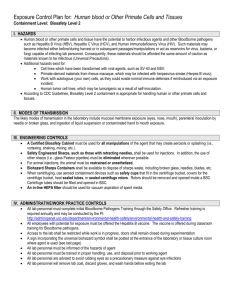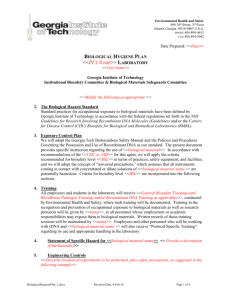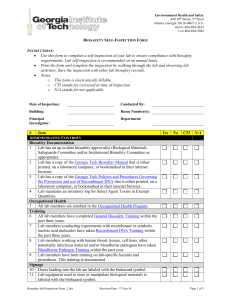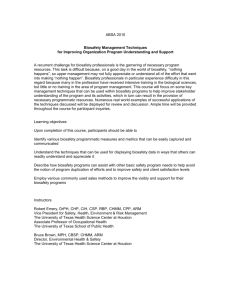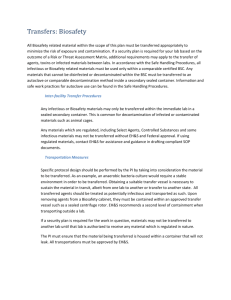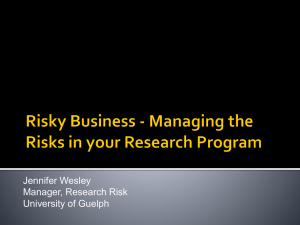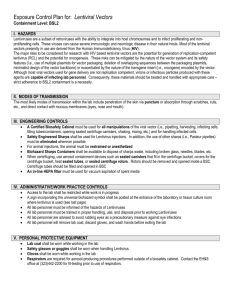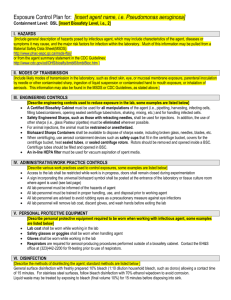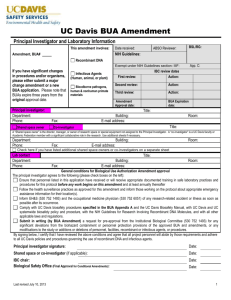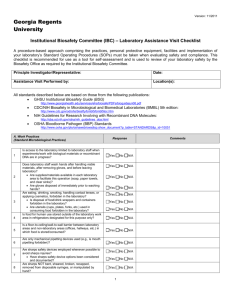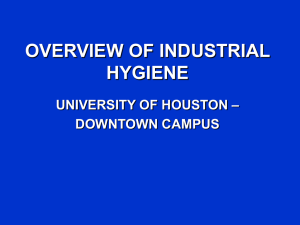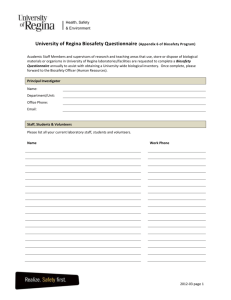OConnell Lab Training () - Berkeley Biomechanics Laboratory
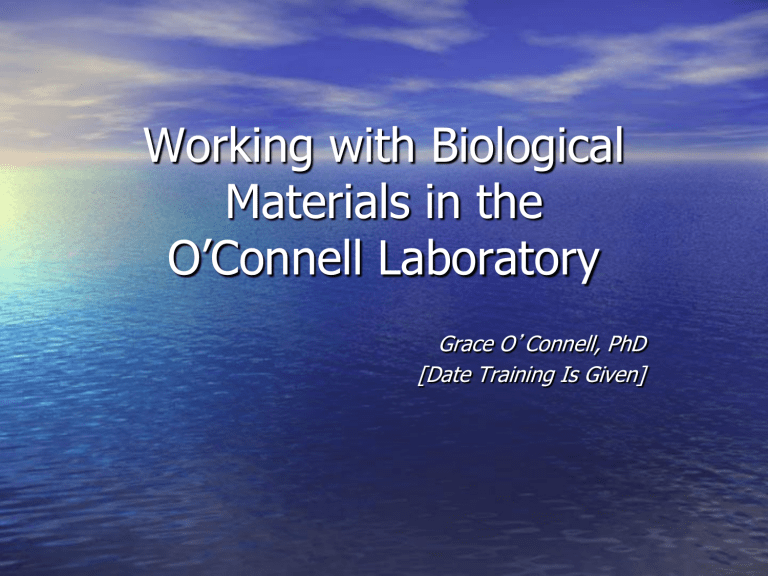
Working with Biological
Materials in the
O’Connell Laboratory
Grace O ’ Connell, PhD
[Date Training Is Given]
Basic Requirements
Research involving biological agents is regulated by the National Institutes of
Health (NIH), Centers for Disease Control and Prevention, the US Department of
Agriculture and the State of California. UC
Berkeley requires a BUA approved by
CLEB prior to the initiation of the experiment. CLEB works with campus
Biosafety Officer Bob Hashimoto, who can provide additional guidance
( bobhash@berkeley.edu
or 643-6562).
Purpose of This Training
UC Berkeley and CLEB require that the PI provide lab-specific biosafety training on the hazards of the specific experimental procedures used in their laboratory to members of their research group. One way to document this training is to record it in the minutes of a group meeting, listing all participants.
Contents of This Training
• CLEB Administrative Requirements
• Role of the Investigator/Lab Staff
• Description of the Experiment-BUA
– The Agents Used
– The Template
• Risk Assessment/Biosafety Level
– Good Work Practices
– Personal Protective Equipment
– Engineering Controls
• Waste Disposal/Decontamination
• Emergency Procedures
CLEB Administrative Requirements
• CLEB requires the following from every PI approved to use biological agents:
– Train all research group members on labspecific hazards and procedures
– Report incidents involving biological agents and clinical specimens immediately to EH&S
– Submit a BUA amendment for any change in personnel or Scope of Work
Description of the Experiment-BUA
The Scope of Work-from the O ’ Connell BUA narrative
• The scope of the research includes mechanical testing of animal and human samples and cell culture.
• Spine sections will be acquired either from a local abattoir or through a donor bank (e.g. NDRI for human samples).
• Care should be taken when using equipment for sample preparation and testing. Equipment should be considered as biohazard contaminated (performed in
2166 Etcheverry).
Description of the Experiment-BUA
The Agents Used
The O ’ Connell lab uses the following:
• Human specimens
• Animal specimens (bovine)
• Human Cells
Description of the Experiment-BUA
The Risks That May Affect Containment Level
These are some of the common experimental risks associated with our research:
• The primary route of exposure of our biological materials is through the bloodborne route. Procedures involving sharps, especially when handling human and animal subjects is of primary concern.
• All employees and students are encouraged to receive vaccination against hepatitis B.
• All used sharps should be placed in rigid hard plastic sharps containers that will be brought to the red bag consolidation area for disposal as medical waste.
• Reusable metal sharps shall be autoclaved at 121 degrees C for 30 minutes and 20 PSI.
Description of the Experiment-BUA
The Risks That May Affect Containment Level
• All human clinical specimens shall be handled with standard Universal Precautions.
• Universal Precautions is an approach to infection control. According to the concept of Universal
Precautions, all human blood and certain human body fluids are treated as if known to be infectious for HIV,
HBV, and other bloodborne pathogens.
• Our lab will perform analytical and tissue culture studies with human and animal specimens.
• You should apply 10% bleach and 70% ethanol as disinfectants to clean up following an experiment.
Risk Assessment/Biosafety Level
Summary of Good Work Practices
• Wash Hands Frequently
• Use Personal Protective Equipment and
Engineering Controls
• Minimize Use of Sharps and if used, handle carefully
• Do Not Eat, Drink, or Smoke in the lab
• Disinfect Work Areas
Risk Assessment/Biosafety Level
Good Work Practices
• Centrifugation: During cell preparation, samples will need to be centrifuged in a sealed vial (the centrifuge will contain a cone and will be self contained).
– Transport samples in sealed tubes placed in a tube rack. Care will be taken to avoid spillage.
Risk Assessment/Biosafety Level
Good Work Practices
• Sample preparation: Spine samples will need to be dissected for biomechanical studies.
– Proper safety attire shall be worn, including gloves, lab coat, safety goggles, and appropriate clothing
• Never work in the laboratory alone.
Risk Assessment/Biosafety Level
Good Work Practices
• Room 5102 is additional wet lab space to perform assays.
• Sample Transportation: When transporting samples between rooms, make sure solutions are sealed and placed in a hard sided container.
• Samples should be fixed with 4% paraformaldehyde or previously frozen at -20 o C prior to transportation. Fixing and freezing are effective methods make the tissues no longer viable.
• All solutions will be labeled and biohazard solutions will be labeled with a biohazard sticker.
Risk Assessment/Biosafety Level
Good Work Practices
• Autoclave: Tools that will need to be used sterilely will be autoclaved. These items include medical tools, glass bottles, and pipette tips.
• Note: Biohazard waste should be disposed of in red biohazard bags and disposed of through EH&S.
Biohazard waste should not be autoclaved.
• Caution: Autoclaves can be a physical hazard due to the heat and steam so no one is permitted to use it unless they have been trained on the safety procedures and how to operate the settings.
Risk Assessment/Biosafety Level
Personal Protective Equipment
• The following personal protective equipment must be worn when manipulating tissue or using the biosafety cabinet:
– Gloves (latex or nitrile)
– Water resistant lab coat
– Goggles/safety glasses
Risk Assessment/Biosafety Level
Engineering Controls
• The following engineering controls must be used whenever handling tissue in the laboratory:
– Biosafety cabinet
– Sink for Hand Washing
– Mechanical pipettes
– Sealed vials
– Sharps containers/Broken Glass box
– Eyewash/deluge shower (use only in an emergency)
Waste Disposal/Decontamination
• Waste Disposal: Tissue culture plastic used for cell culture will be bleached then disposed of in a biohazard bag. Red bag waste shall be picked up by Environmental
Health and Safety.
• Paraformaldahyde and any mixed biological and chemical waste solutions should be disposed of through
EH&S as chemical waste.
• Spill procedures (biological tissues/blood/waste):
Clean spills by soaking it in 10% bleach for 20 minutes before cleaning up and disposing as biohazardous waste.
– Notify Dr. O’Connell and EH&S of any spills within 8 hours.
Emergency Procedures
• In the event of a laboratory accident:
– Tend to injured person, wash the wound with water.
– Notify Dr. O’Connell or the lab supervisor
IMMEDIATELY so that CLEB and the Biosafety
Officer can be notified within 8 working hours.
– Initiate clean up procedures.
– Notify EHS, if the PI is not available, 642-3073 or
642-3333 (After Hours)
– Seek medical attention at Tang or the Alta Bates
ER at 2450 Ashby Avenue after hours.
Conclusion
This training is designed to inform you of the regulatory requirements regarding use of biological materials and our lab ’ s implementation of the campus safety requirements.
All experiments with human clinical specimens by CLEB and any changes require an approved amendment to the
BUA.
Contact the Biosafety Officer for assistance, if needed (Bob Hashimoto).
